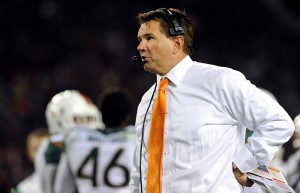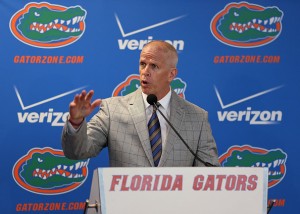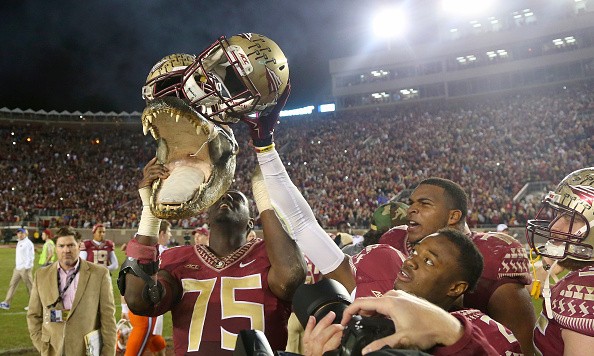Florida, Texas, California. Those three states are considered the current pillars of college football for recruiting, and it makes sense that all three have had teams see success on the national stage in recent years.
Intra-state rivalries are a different beast from regular conference match-ups and bring an extra dose of familiarity with the annual meetings. Many players from these states were on the same high school teams or from the same area, so the rivalry has a personal element to it. This extends to the fans as well.
Chances are every Florida State fan knows at least one Gator or Hurricane fan that he or she is friends with. It’s the nature of living in a state with multiple prestigious programs that produce thousands of alumni each year.
Florida is…different, however. While the other two states certainly have large programs that regularly duel, the “Big 3” Florida teams (FSU, UF, Miami) are renowned for having the most success since the BCS era began and ended. Teams from Florida appeared in eight national championships since 1998, winning five of them.
FSU appeared in both the first and the last BCS National Championship, which was quite a fitting way to symbolize the impact teams from Florida had on the college football landscape.
That era is obviously over with the invention of the College Football Playoff and we are left with the Seminoles as the head of the state. They have now beat both Miami and Florida in four of the past five seasons while witnessing some of the greatest success the school has accomplished yet.
Meanwhile, both the Gators and Hurricanes seem to be in a rut of sorts. Lackluster season after lackluster season with a sprinkle of dashed hope has left both fan bases antsy to return to their previous status.
How did we get here exactly? While it’d be nice to say that FSU achieved this status through means of its own, a perfect storm of sorts hit their rivals and allowed them to take an edge in both recruiting and on-field performance. A quick breakdown of each team’s last five seasons presents this:
Miami Hurricanes
Combined Record: 35-28
Avg. Recruiting Rank: #21
Players Drafted: 26
Notable Achievements: Three bowl games
Florida Gators
Combined Record: 37-26
Avg. Recruiting Rank: #10
Players Drafted: 26
Notable Achievements: Four bowl games (1 BCS), one Consensus All-American
Florida State Seminoles
Combined Record: 58-11
Avg. Recruiting Rank: #5
Players Drafted: 36
Notable Achievements: Five bowl games (3 BCS/playoff), national championship, three conference championships, nine Consensus All-Americans
*
The gap is striking. The last time either Miami or Florida beat FSU was the 2012 match-up between the Gators and the Seminoles at Doak Campbell Stadium. That was also the one season where Florida went to the Sugar Bowl and finished out the year at 11-2.
For a while, it looked like the Gators would once again become a force to contend with in the state and challenge FSU for supremacy. We all know what happened the next season with the 4-8 record and the Georgia Southern loss at home.
It’s no surprise that the two teams with better recruiting rankings have more consensus All-Americans, nor is it shocking that they go to bowl games more often than the first one. For at least Florida and Florida State, talent is not the issue.

TALLAHASSEE, FL – NOVEMBER 12: Allen Hurns #1 of the Miami Hurricanes misses a touchdown catch as Christian Jones #7 of the Florida State Seminoles looks on during a game at Doak Campbell Stadium on November 12, 2011 in Tallahassee, Florida. (Photo by Mike Ehrmann/Getty Images)
A lot will disagree with the assertion that Miami doesn’t have talent by looking at the draft numbers, but it’s not totally clear that this is the best way to determine the issue. A large majority of those drafted from the university were already 4-stars coming in, so they naturally had enough talent that they could have succeeded in a lot of places. Initially, this would seem contradictory: If the 4-stars are getting drafted, that would mean the team clearly had a lot of talent right? Well, not really.
Often times those 4-stars are the only ones on the team with any future in the league. The cream of the crop might be noticeable, but there is a large gap between them and the rest of the team which is probably not as talented.
Bud Elliot looked at percentage of blue chips for FBS teams and the Miami result illustrates the point: The Hurricanes only have 31 percent of their roster made up of blue chips, well below the 56 percent and 54 percent by FSU and Florida, respectively. Both of the aforementioned schools and out-of-state programs have been coming into the South Florida area and poaching recruits left and right for years now.
Miami’s inability to secure it’s own ground and convince highly-rated recruits to stay home has left it dead in the water with regards to general competitiveness. When the Hurricanes joined the ACC, it was expected that they would be contending for conference championships every season — they have yet to play for one.
Much of this falls on the coaching staff, certainly. Al Golden is supposedly on the hot seat and needs at least eight wins to keep his job for next year, but let’s also remember the situation that Miami has been in for years now regarding the (sham) NCAA purveyance into the program.
The program was put under serious scrutiny while the NCAA continuously dropped the ball during an investigation that spanned years. Self-imposed bowl bans and the real threat of further sanctions meant recruits got turned off at the prospect of playing for “The U” where they might be punished for their whole playing careers.

BLACKSBURG, VA – OCTOBER 23: Head coach Al Golden of the Miami Hurricanes looks on in the first half against the Virginia Tech Hokies at Lane Stadium on October 23, 2014 in Blacksburg, Virginia. (Photo by Michael Shroyer/Getty Images)
There’s something to be said for the effect Donna Shalala had within the athletic program as well. Regardless of how many feel about her overall impact on the university, not many will disagree that the football team suffered as a result. Hirings of Randy Shannon and Al Golden combined with the Nevin Shapiro situation and move to Sun Life Stadium brought the program to its knees.
She made the right decision by taking the NCAA to task for screwing up its investigation, but that’s not enough to really make up for the decisions she has made over the past decade. Rumors that she interfered too much were also circling, though there’s not much to really confirm that. It was announced recently that she’d be stepping down at the end of the year and presumably letting the athletic director regain control. If Miami is lucky, her departure will be the start of good things to come for the school.
For now however, the Hurricanes are still trying to build a base to progress from. As much as it pains some fans to hear this, it doesn’t look like Miami will be out of this stagnation for at least a few years. A best case scenario would be Golden turning the team around and discovering a pot of gold in his mediocre recruiting classes, while leading them to a season of nine wins or better.
That has a good 1 percent chance of happening. Most likely is that he’ll do enough to justify keeping him while still angering fans who want to see better results from the team. Quite honestly, it looks like the best long term scenario might be for the Hurricanes to have a bad season and get Golden out while they look for a new coach to lead them — a total restart if you will.
The Gators have a slightly easier situation to rectify. They are right up there with other elite teams like FSU in terms of recruiting and talent, though quite obviously the results haven’t been apparent. When a team has both the necessary recruiting rankings and NFL talent to succeed, yet goes 4-8 with a loss to an FCS team, there is really only one thing to blame: coaching.
Others will chime in with the injuries excuse, but the recent 8-5 season made it abundantly clear that the injuries were not the primary problem. Yes, they obviously hurt the team during the 2013 season, but it should be noted that even in their most embarrassing loss, the opponent had more scholarship players injured than the Gators.
Will Muschamp’s inability to find an offense worth a penny was what ultimately did them in more than anything. Their defensive rankings stayed in the good to great category for most of his time there. While it will be irritating for Florida fans to witness talents like Vernon Hargreaves III and Dante Fowler Jr. seemingly waste their careers on mediocre teams, it is the unfortunate byproduct of having a coach that can’t balance his skill set.
In retrospect, this makes the 2012 season all the more confusing, though a quick survey seems to reveal at least part of the reason: Florida won three games that season by one score or less, including wins over Missouri, Louisiana-Lafayette, and Texas A&M early in the season before Johnny Manziel emerged. Muschamp’s teams got some luck like most teams do and were able to propel themselves to the Sugar Bowl in an exciting, if not painful for FSU fans, fashion.

GAINESVILLE, FL – DECEMBER 06: Florida Gators athletic director Jeremy Foley speaks on during an introductory press conference on December 6, 2014 in Gainesville, Florida. Jim McElwain has left Colorado State and replaces ex-Florida head coach Will Muschamp who was fired earlier this season. (Getty Images)
There’s not much to speak about with Florida’s program as a whole because they have a very good foundation. Jeremy Foley is a good athletics director (if not a bit unwavering on some aspects) who has had more positive years than negative while in Gainesville.
Unless Charley Pell somehow possesses new head coach Jim McElwain, there aren’t any indicators of a program on the decline for a while. Foley whiffed on the last hire, but the resources that Florida has make it a very desirable place to coach and succeed at.
Of course, neither of these would mean much if FSU hadn’t made the decisions it did to succeed in the college football world. Fellow Noled Out writer Mike Ferguson laid out 10 big reasons why FSU re-emerged as a power to be reckoned with, and it is a very good summary of how exactly we got here.
If there was one thing that has to be mentioned, it would the hiring of head coach Jimbo Fisher. It is very hard to understate the impact he had on bringing Florida State football back, especially when one considers all the areas that Fisher has revived since his hiring in 2010.
Readers might have noticed the common trope in both the Miami and Florida recaps: coaching. School administrations, whether supportive or harmful, can only have so much impact on how a team performs on the field. A good coach can rectify all that however. The head shot-caller who can bring in the guys to run his system and be able to lead them on the field can turn even the lowliest programs into competitors year in and year out.
To summarize, it was a bit of a perfect storm to get FSU to where it is now. The Seminoles got better and better each year while its in-state competition got weaker and kept making bad decisions.
In effect, this let Florida State become the top destination in the state of Florida for recruits wanting to make it to the next level and play for a competitor. Fisher’s prowess at both coaching and recruiting would seal the deal and be a big reason that the team is 9-1 against Miami and Florida over the past five years.
Seminole fans should enjoy it while it lasts. In a not so distant future, all it takes is one home-run hire and either rival could be going toe-to-toe once more for state supremacy. Heavyweight battles with both teams being ranked high could emerge after years of dormancy.
Of course, maybe that’s what having the Big 3 is all about.




















